- The shield masks produced by ISD researchers and students are donated to hospitals, urgent and emergency services, as well as maternity wards, in Rio Grande do Norte. For more information and step-by-step instructions for requesting a donation, click here.
- ISD receives donations of production inputs (acetate and 3D printer filaments), broken printers - to build new machines and speed up work - as well as money to purchase inputs. Financial donations are possible by transfer, credit card or PayPal. For step-by-step donation instructions click here
- 3D printing filament and acetate for face shield are sold out or the delivery dates are unsuitable. Building mechanical ventilators is expensive, and now we need your collaboration. Please donate materials or cash if you wish. Click here I know more.
'Shield masks', also called 'face shields', are essential to the work of healthcare professionals in procedures with a higher risk of contamination. They are, however, scarce on the market given the explosion in demand with the coronavirus (Covid-19) affecting the world.
Those produced at the Edmond and Lily Safra International Institute of Neuroscience (IIN-ELS), at the Santos Dumont Institute (ISD), are donated and not sold.
Leading the project are researchers and students from master's degree in neuroengineering of the Institute.
In this production line, parts are 'built' with the help of 3D printers, at a cost of R$ 5 per unit. They are made from plastic acetate and are similar to products currently sold on the internet for prices ranging from R$ 25 to R$ 90.
When to use
According to National Health Surveillance Agency (Anvisa), facial protectors such as these must be used when there is a risk of exposing the professional to blood spatter, body secretions and excretions. The British public health service reinforces that this type of equipment also helps protect against contamination caused by respiratory droplets and aerosols.
How to use
- The 'shield mask' must be used in conjunction with other PPE: Cap, apron, gloves, disposable mask and glasses.
- It must have the necessary dimensions to cover the front and sides of the face.
How to clean acetate mask
- With soap and water;
- Alcohol 70%
- Or hypochlorite on gauze or cotton, so as not to scratch the material.
*After correct cleaning, the product can be reused.
How to help overcome production challenges
The shortage of raw materials to make masks is one of several challenges that researchers face in increasing supply to hospitals.
In addition to acetate – the film used to make the front part of the parts – there is a lack of filament rolls for 3D printers (materials that in common printers would fulfill the role of ink), in addition to a greater availability of machines for the work and more efficient logistics. quick way to transport materials.
*For more information about how to collaborate with the donation of materials or money for the production of the ISD, click here.
*For more information about who we donate the masks to and the step-by-step guide to requesting a donation, click here.










